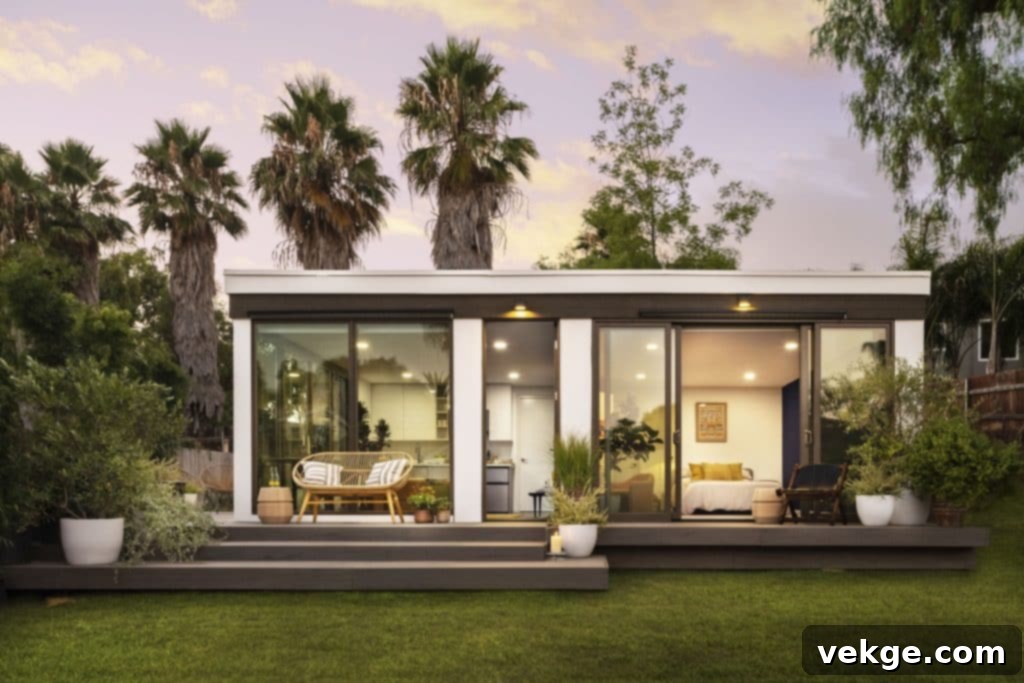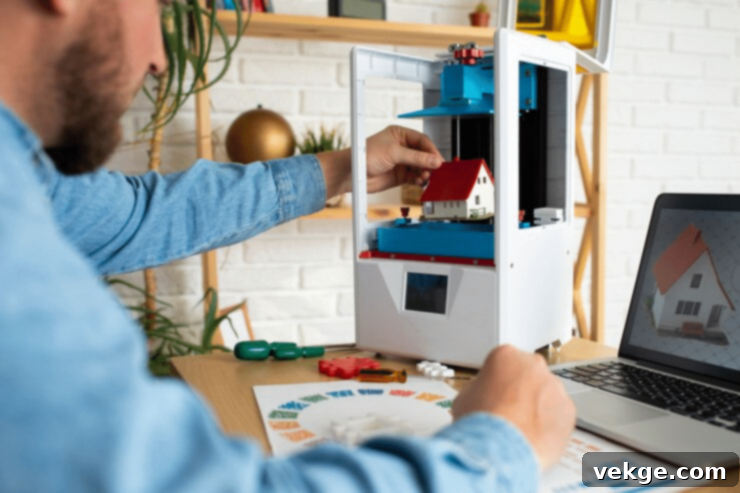The Future of Mobile Living: How 3D Printing is Revolutionizing Sustainable Homes
The concept of mobile homes has undergone a remarkable transformation over the years, shedding outdated stereotypes to emerge as a symbol of sustainable, adaptable, and highly personalized living. As technological advancements continue to accelerate, so too do the possibilities for constructing and designing our homes. This evolution is particularly evident in the realm of mobile housing, where innovation is paving the way for unprecedented levels of efficiency and customization.
Among the most compelling innovations shaping this sector is the integration of 3D printing. This cutting-edge technology is not merely an improvement on traditional methods; it’s a paradigm shift that redefines what a house can be. By enhancing efficiency in the construction of mobile homes, 3D printing unlocks new avenues for bespoke design, functional integration, and environmental responsibility, pushing the boundaries of conventional building.
Redefining Construction: 3D Printing in Mobile Home Design

The inclusion of 3D printing in the mobile home production process heralds a new era of design and construction. This additive manufacturing technique allows for the rapid production of intricate, durable, and remarkably lightweight structures. Unlike conventional building, which often involves extensive labor and material waste, 3D printing constructs homes layer by layer, leading to significant material savings and reduced construction times. This precise methodology grants designers an unprecedented level of control over both the architectural form and the interior layout, enabling them to realize complex visions that were previously deemed impossible or prohibitively expensive.
For individuals intrigued by the potential of mobile homes and considering a purchase, comprehensive resources are invaluable. Before making a significant investment, understanding a vehicle’s history is crucial. Visit epicvin.com for receiving comprehensive insights and resources, particularly in verifying their history, ensuring an informed and confident purchase.
Unleashing Creativity: Design Possibilities with 3D Printing
The transformative power of 3D printing technology extends an expansive canvas of design opportunities to architects and designers. Gone are the limitations imposed by traditional construction methods, which often constrained shapes and structures due to cost or complexity. With 3D printing, designers can now experiment with organic curves, complex geometries, and integrated features that were once only conceptual. Imagine wall patterns specifically engineered to enhance thermal insulation, or furniture seamlessly folded into the very structure of the home – the possibilities are truly as vast as human imagination.
Beyond aesthetic appeal, 3D-printed homes excel in functionality. They can be intrinsically designed for modularity, a feature that holds immense value for mobile homes. This inherent modularity empowers owners to easily expand or reconfigure their living units in response to changing needs. Whether it’s adding an extra room for a growing family, creating a dedicated workspace, or simply repositioning internal walls to adapt to different lifestyles, the adaptability provided by 3D printing makes modifications easy, efficient, and significantly less disruptive. This level of flexibility ensures that a mobile home can evolve with its occupants, offering a truly dynamic living solution.
Moreover, 3D printing facilitates the creation of highly customized interiors. Built-in storage solutions, unique shelving units, and even specific textures can be directly integrated into the walls and structures, maximizing space and enhancing functionality within a compact footprint. For those looking to invest in this innovative technology and push the boundaries of design and construction, identifying the best commercial 3D printer is paramount to achieving optimal results and unlocking the full potential of additive manufacturing.
Sustainable Foundations: Material Innovations in 3D Printing
The advancement of 3D printing materials is equally pivotal to the progress and sustainability of mobile homes. One popular and environmentally conscious alternative is polylactic acid (PLA), a biodegradable polymer derived from renewable resources such as corn starch. PLA offers an excellent balance of properties: it’s lightweight, which is crucial for mobile structures, and exhibits good weather resilience, ensuring durability in various environments. Its eco-friendly profile provides significant environmental advantages, aligning perfectly with the growing demand for sustainable living solutions.
However, the innovation doesn’t stop at PLA. Recent discoveries have introduced a new generation of materials that can replicate, and often surpass, the performance and aesthetic appeal of traditional construction materials like wood, metal, and concrete. These advanced composite materials offer superior insulation properties, enhancing energy efficiency within the home and reducing heating and cooling costs. They also boast increased strength-to-weight ratios, contributing to the overall structural integrity of the mobile unit while keeping it light enough for transport. Furthermore, the precision afforded by 3D printing with these materials allows for extremely detailed designs and integrated functionalities, such as channels for wiring or plumbing directly within the walls, streamlining the construction process and improving the overall quality of the build.
Researchers are also developing smart materials that can respond to environmental changes, such as self-healing concrete, or materials capable of generating energy, paving the way for truly self-sufficient mobile homes. The continuous exploration and refinement of these innovative materials are crucial in expanding the capabilities and sustainability of 3D-printed mobile housing, making them not just homes, but intelligent, resilient living systems.
Navigating the Path Forward: Challenges and Solutions
While the adoption of 3D printing in mobile home design presents a multitude of advantages, it is not without its challenges. Initial investment costs for advanced 3D printing technology remain a significant hurdle for many, alongside the demand for highly skilled operators to manage and maintain these sophisticated systems. Furthermore, the current pace of printing large-scale structures, though improving, can sometimes be slower than desired for mass production. Nevertheless, these obstacles are being steadily overcome. The continuous evolution of 3D printers is leading to more affordable and efficient models, while a growing number of training programs are equipping a new workforce with the necessary expertise, making the technology more accessible and practical.
Beyond technological and economic factors, regulatory issues also pose potential barriers. Many existing zoning laws and building codes were established long before the advent of 3D printing and have not yet fully adapted to this revolutionary mode of construction. This often leads to delays in permitting and a lack of clear guidelines for compliance. To address this, active engagement with regulatory bodies and participation in pilot projects are vital. By demonstrating the safety, efficiency, and structural integrity of 3D-printed homes through real-world applications, industry leaders can work collaboratively with authorities to develop updated standards and foster broader acceptance and integration of 3D printing within the housing sector. Furthermore, educating the public about the benefits and safety of these innovative homes can help to dispel misconceptions and accelerate their mainstream adoption, ensuring that the future of housing is built on a foundation of innovation and progress.
Beyond the Horizon: The Environmental Impact and Future of 3D-Printed Mobile Homes
The environmental advantages of 3D printing in mobile home construction are profound and extend far beyond just material choices. By enabling precise, on-demand manufacturing, 3D printing dramatically reduces construction waste, a major contributor to landfills. This waste reduction minimizes the ecological footprint of building new homes. Furthermore, the ability to print components locally can significantly cut down on transportation costs and associated carbon emissions. Many 3D printing processes also allow for the use of recycled content in their building materials, closing the loop on a more circular economy.
Looking ahead, 3D printing offers an exciting pathway toward truly self-sufficient and off-grid mobile living. Designs can integrate advanced energy-harvesting features, such as solar panels seamlessly incorporated into the roof structure or wind turbines built into the home’s profile. Water collection and recycling systems can be directly integrated into the printed walls, maximizing resource efficiency. This holistic approach to design and construction, enabled by 3D printing, means that future mobile homes will not only be adaptable in their physical layout but also incredibly resilient and environmentally responsible in their operation. They represent a significant step towards a future where housing is not only innovative and personalized but also deeply harmonious with our planet.
Conclusion: Printing the Future of Adaptable Living
In summation, the integration of 3D printing technology into the field of mobile home design is far more than a mere technical novelty; it is a revolutionary force poised to fundamentally reshape our understanding of home, community, and construction itself. As this technology continues to mature and improve, it will not only expand the realm of what is physically possible in terms of structural integrity and aesthetic complexity but will also redefine what it means to construct and inhabit spaces that are truly designed for the dynamic and evolving patterns of modern life.
The mobile home design revolution is not a distant dream; it is happening now, being printed layer by layer. This exciting transformation is opening new horizons for sustainable, efficient, and deeply personalized living, promising a future where our homes are as adaptable and unique as we are. With 3D printing, the path to a more innovative, eco-friendly, and responsive housing landscape is being meticulously built, one innovative structure at a time.
